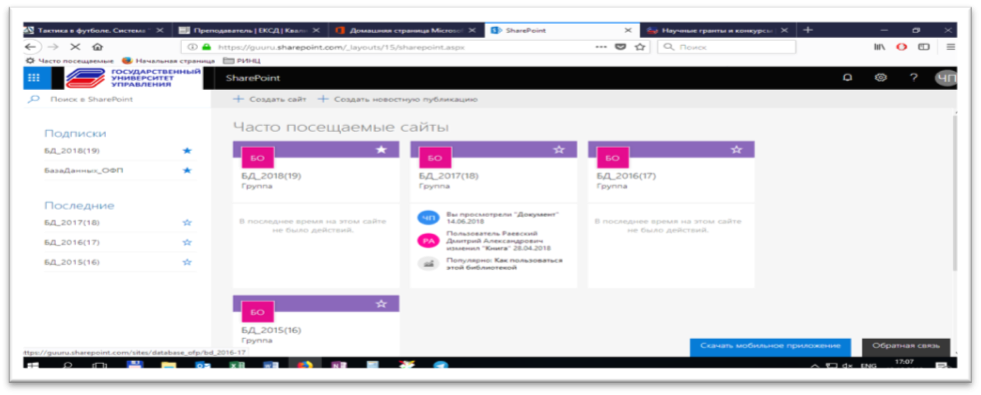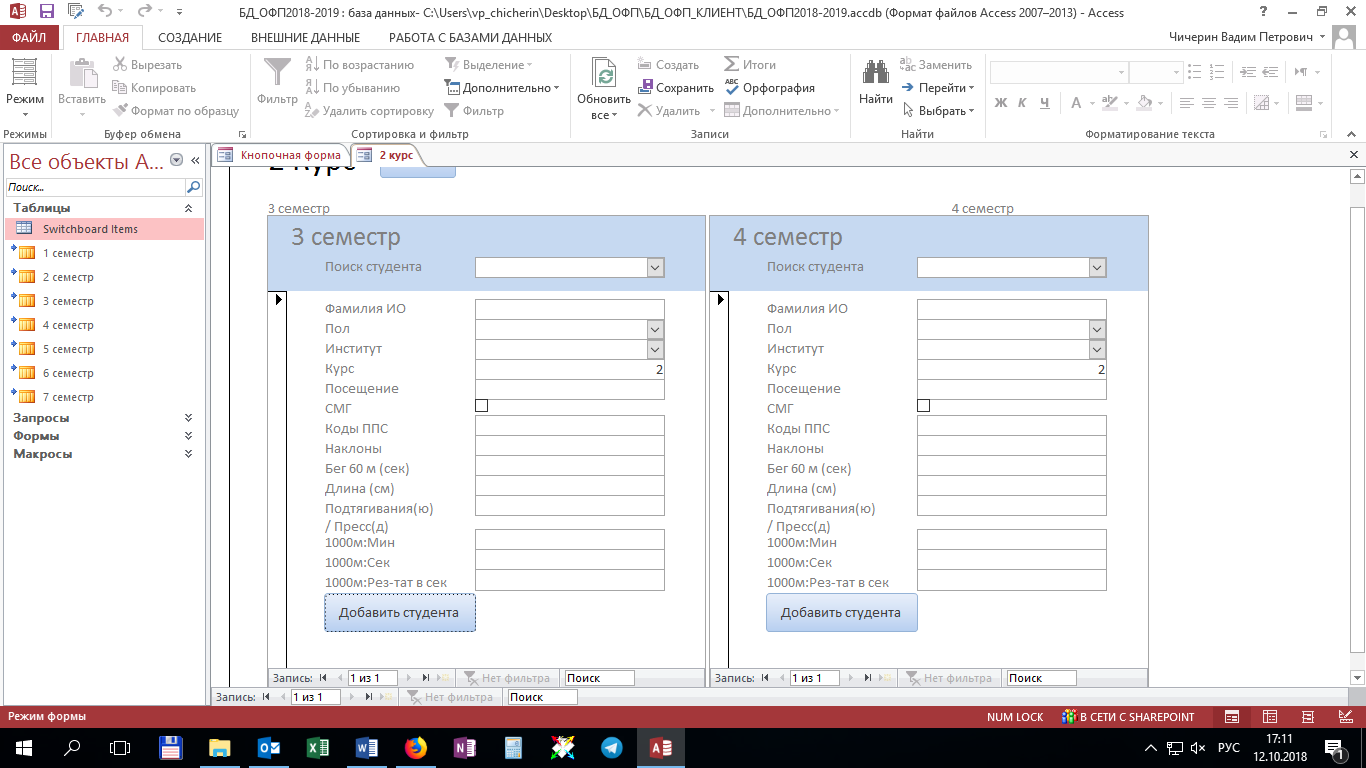Academic physical fitness test data processing and interpretation system
ˑ:
PhD, Associate Professor D.A. Rayevsky1
PhD, Associate Professor V.P. Chicherin1
PhD, Associate Professor V.S. Domashchenko1
Associate Professor V.P. Rumyantsev1
1State University of Management, Moscow
Keywords: database, all-round physical fitness, physical fitness tests.
Background. Modern physical education service is governed by the advanced didactic logics in its training methods, progress tests [2-5] and health sports service models, with the physical progress paths analyzed, harmonized and facilitated by the interactive education tools. Certain progress stereotypes created in the interactive environments are tested in practice with a feedback data flows used to analyze the progress for a certain time period by the relevant sport-specific physical fitness, skills and qualities rating tests. Modern digital technologies are given a growing priority by the national universities in their efforts to design and maintain efficient IT systems for many educational service missions including the academic physical education service excellence ones.
Objective of the study was to develoop and test benefis of a new academic physical fitness test data processing and interpretation system.
Methods and structure of the study. The new academic physical fitness test data processing and interpretation system was designed with application of the modern SharePoint and Microsoft SharePoint Products and Technologies to offer an online resource for the academic physical education faculty. The new toolkit accessible on the academic website makes it possible to track, on a timely and efficient basis, the students’ physical fitness test data and the academic attendance statistics and process a variety of the academic physical education service reports and projects: see Figure 1.

Figure 1. Students’ physical fitness test database
We used Access software tools to create customized user-friendly windows for operations with the database: see Figure 2.

Figure 2. Windows hierarchy for operations with the database
The Access toolkit was customized to the physical education Department missions and needs, with the operations synchronized with the Microsoft cloud services to effectively benchmark and analyze the students’ physical progress test statistics and timely track positive and negative trends in the physical education service.
In addition to the physical fitness test data processing, the system gives the means to fix the individual/ group/ course academic attendance, analyze the data flows and make timely recommendations on how the training process should be updated to exclude or add some exercises when necessary to spur up one or another physical quality building process. The system makes it possible, therefore, to improve efficiency of the academic physical education sessions within the standard timeframe.
The system offers the data categorization by names, academic years, gender, physical fitness test rates and many other criteria and gives the means to process the academic physical education service reports for about 3,000 students on at least a semester-wise basis; with the data processing tools easily customizable on a time- and cost-efficient basis. The Microsoft Excel based toolkit of the new system offers an extensive statistical data processing capacity with automated computations of the t-criteria and regression rates.
The new system gives to its corporate clients the joint physical fitness progress tables for the operational data processing, with the service offering new standard editable fill-in forms for synchronized data with an efficient statistical data processing capacity.
Results and discussion. To test benefits of the new academic physical fitness test data processing system, we sampled the first- (n=706), second- (n=110) and third-year (n=34) students and tested their physical fitness in September and May (the first and last academic year months): see Figure 3.

Figure 3. Physical fitness test data input form
The tests found the 3-year [male] group making regress versus the 1-year group in the speed (р<0.01), speed-strength (р<0.01) and relative strength (р<0.01) tests, and only endurance tests showed insignificant intergroup changes. It should be also mentioned in this context, that the prior studies [1] found the 1-year [male] students making significant regress for the summer vacation period in the speed test rates and notable regress in the endurance test rates.
We also used the new database to analyze the female group’s physical fitness statistics. The tests and analyses showed progress of the 1-year female students in the standing long jump and forward bend tests (р<0.01). The 2- and 3-year female students were tested with insignificant changes in the speed, speed-strength and the abdominal muscles speed-strength endurance tests; and the 3-year female students were tested with some progress in the endurance tests (р <0.01).
The study data and analyses demonstrated benefits of the new system as verified by the effective tracking of significant progress in the speed, speed-strength and relative strength tests in the male group; and the standing long jump and abdominal muscle strength tests in the female group.
Conclusion. The experimental data show that the digital data processing system gives the means to efficiently customize the education service, whilst the cloud services help shape up and advance the faculty’s theoretical and practical operations. Online operations in the database facilitated by the user-friendly interface were tested highly time- and cost-efficient. The new academic physical fitness test data processing and interpretation system provides efficient tools for the academic physical progress tests and analysis.
References
- Gorulev P.S. Upravlenie sportivnoy podgotovkoy zhenshchin v tyazheloy atletike s uchetom dimorficheskikh razlichiy rabotosposobnosti: avtoref. dis. dokt. ped. nauk [Management of athletic training in women's weightlifting in view of dimorphic differences in working capacity: Doct. diss. abstract. dis. (Hab.)]. Chelyabinsk, 2006, 48 p.
- Guba V.P., Konovalov V.V., Presnyakov V.V. Morfobiomekhanicheskaya individualizatsii kak effektivny metod integratsii VFSK GTO v sistemu obschego obrazovaniya [Morphobiomechanical individualization as efficient method to integrate GTO complex to general education system]. Teoriya i praktika fiz. kultury, 2016, no. 11, pp. 94-97.
- Guba V.P. Osnovy sportivnoy podgotovki: metody otsenki i prognozirovaniya (morfobiomehanicheskiy podkhod) [Fundamentals of sports training: methods of assessment and prediction (morphobiomechanical approach)]. Scientific-method. guide. Moscow: Sovetskiy sport publ., 2012, 384 p.
- Guba V.P., Marinich V. V. Teoriya i metodika sovremennykh sportivnykh issledovaniy [Theory and methods of modern sports research]. Moscow: Sport publ., 2016, 230 p.
- Karpeeva N.V. Fiziologicheskaya kharakteristika vliyaniya silovykh uprazhneniy na organizm zhenshchin reproduktivnogo vozrasta: avtoref. dis. kand. biol. nauk [Physiological characteristics of effect of strength exercises on the body of reproductive aged women. PhD diss. abstract]. Ryazan, 1999, 23 p.
- Nikolaev P.P., Nikolaeva I.V. Integralny analiz modelnykh morfofunktsionalnykh kharakteristik devushek [Integrated analysis of model morphofunctional characteristics of female representatives of mass categories in power triathlon]. Teoriya i praktika fiz. kultury, 2017, no. 9, P. 104.
- Parfenova L.A., Gordeeva G.A. Predlozheniya po sovershenstvovaniyu normativno-testiruyushchey chasti kompleksa GTO [Suggestions for improvement of the regulatory-testing part of GTO complex]. Uchenye zapiski un-ta im. P.F. Lesgafta, 2014, no. 9, pp. 114-118.
Corresponding author: kaf_fiz@guu.ru
Abstract
The study was intended to test benefits of an academic physical fitness test data processing and interpretation system with application of the modern SharePoint and Microsoft SharePoint Products and Technologies toolkits. The new toolkit accessible on the academic website makes it possible to track, on a timely basis, the students’ physical fitness test data and academic attendance and process the academic physical education service reports and projects.
The academic physical fitness test data processing system was tested on a 4-year student sample. The study data and analyses demonstrated benefits of the new system as verified by the by the effective tracking of significant progress in the speed, speed-strength and relative strength tests in the male group; and the standing long jump and abdominal muscle strength tests in the female group. The experimental data show that the digital data processing system gives the means to efficiently customize the education service, whilst the cloud services help shape up and advance the faculty’s theoretical and practical operations.


